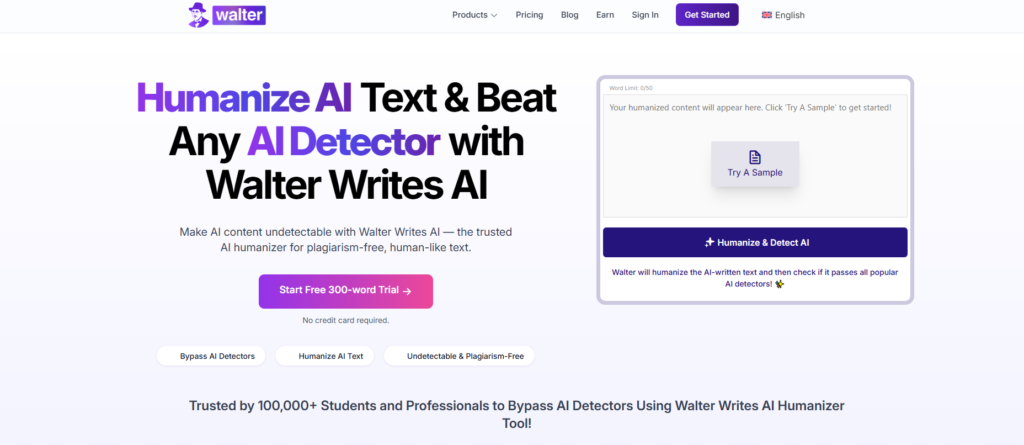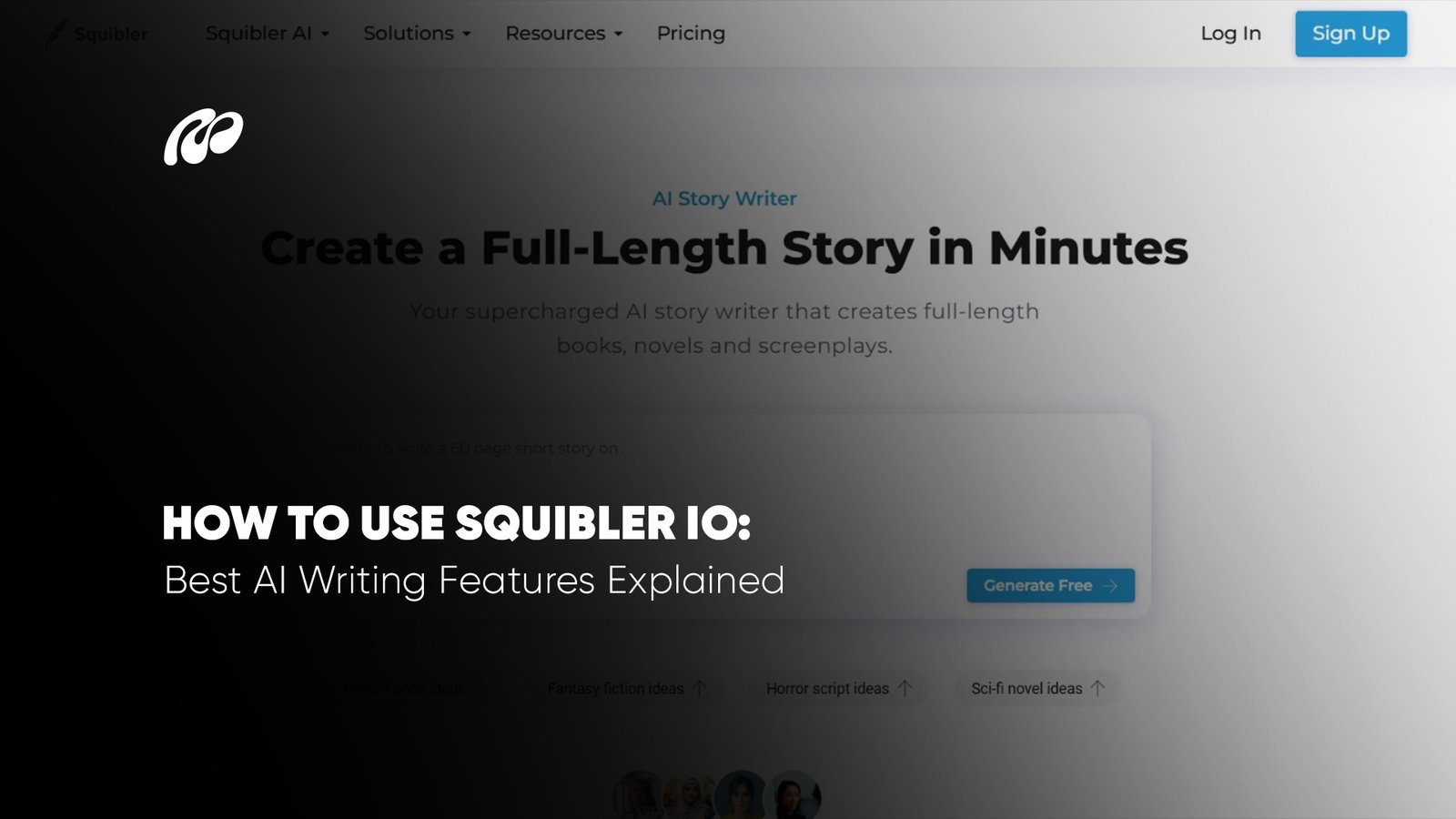Summary
- Walter Writes AI refines AI-generated text into human-sounding, natural language.
- Walter writes AI humanizer adjusts tone, sentence flow, and structure with precision.
- Walter writes AI free offers limited access to test basic rewriting features.
- Feedback across Walter writes AI Reddit suggests success in bypassing AI detection.
- Tiered Walter writes AI pricing supports different user needs from basic to enterprise.
- Walter writes AI detector helps reduce the visibility of machine-written patterns.
- Users manage rewriting tasks efficiently using the browser-based Walter Writes AI app download feature.
- Deciding is Walter writes AI worth it depends on how often and deeply users require natural content output.
Writers and editors frequently face a challenge when it comes to refining AI-generated content, it often lacks emotional depth and reads too mechanically. Walter Writes AI solves this issue with its ability to reshape AI text into natural human language. The platform offers an intelligent solution for those looking to produce clean, reader-friendly output without sounding robotic. Whether you’re a student working on essays, a blogger publishing online, or a marketer preparing client deliverables, this tool supports multiple writing scenarios.
Its standout feature, Walter writes ai humaniser, allows for tone adjustment, rephrasing, and bypassing AI detection tools, all in one streamlined interface. The tool’s popularity isn’t surprising, considering it fills the gap between raw AI content and final drafts ready for use. Many users looking into alternatives, such as Walter writes AI reddit discussions find themselves returning to this platform for its effectiveness. In evaluating AI humanizers, some writers reference systems like TurboLearn, which compares performance across a variety of rewriting tools. The analysis of content structure and fluidity in TurboLearn AI sheds light on how user-friendly interfaces impact real output quality. Meanwhile, the functional comparisons made in Writer AI suggest that tools with sentence-level editing tend to deliver better long-term value for professionals.
How to Use Walter Writes AI: Step-by-Step Guide

Using Walter Writes AI involves a straightforward process that caters to both new and experienced users. It focuses on clarity and ease, minimising the need for technical input while still offering deep customisation. The tool follows a five-step approach, from logging in to reviewing the final output, each helping enhance AI text into polished, human-style writing.
Step 1: Log In to the Platform
Users begin by accessing the secure dashboard through the Walter Writes AI sign in. This login system ensures stored preferences can be applied across sessions, which makes the writing process faster and more consistent.
Step 2: Input Your Content
Once logged in, the user pastes or uploads the raw text. Because the Walter writes AI app accepts multiple content formats, from blog posts to scripts, it becomes a versatile editing assistant for various writing contexts.
Step 3: Choose Custom Settings
After inputting text, users can set preferences such as tone and complexity. Through walter writes ai humanize, this stage defines the style of output, making the final result match the audience’s expectations more precisely.
Step 4: Click ‘Humanize’
The key function is triggered with one click. At this point, Walter writes ai humanizer reconstructs the input based on its training in sentence fluidity and emotional tone, minimizing any robotic artefacts in the original draft.
Step 5: Review and Save
After humanization, the tool provides an option to review and adjust. With the help of Walter Writes AI checker, users can ensure coherence and naturalness before saving the final version to their device or cloud.
What is Walter Writes AI?
Walter Writes AI is a rewriting platform that serves writers looking to improve the natural tone of AI-generated text. It does more than just paraphrase, it processes text in a way that reflects how humans communicate, offering more accuracy and realism in output. The tool’s widespread application, from academia to digital marketing, reflects its adaptable structure.
Conversations in Ask AI reveal a growing interest in tools that understand not just grammar but also reader psychology, which Walter Writes AI accommodates through tone-based settings.
Moreover, comparative reviews from Question AI show that systems designed with intuitive UI and deep-text pattern recognition, like Walter, are becoming preferred choices for long-form content professionals.
Benefits of Using Walter Writes AI
Humanizes AI-Generated Text
One of the core advantages of Walter Writes AI is its ability to humanize rigid, AI-generated content. Instead of just replacing words, it restructures entire sentences to reflect natural language patterns. This makes Walter writes AI humanizer especially useful for writers who want their work to sound organic and free-flowing. The tool understands tone shifts and contextual cues, helping writers avoid stiff or mechanical-sounding outputs across various platforms.
Helps Bypass AI Detection Tools
A growing concern in digital publishing is whether AI-generated content can be flagged by detection tools. Walter Writes AI addresses this by restructuring sentence formation and vocabulary use. With the support of walter writes AI detector, it lowers the likelihood of detection while preserving the intended message. This makes it a reliable choice for content creators navigating strict authenticity standards and algorithm-based screenings on academic or publishing platforms.
Customizable Output Styles
Unlike static rewriters, Walter Writes AI allows for stylistic personalization. Users can set tone, sentence complexity, and vocabulary range, making the tool highly adaptable. With Walter writes AI humanize, content can shift from a casual blog tone to formal business communication easily. The flexible customization options mean the platform works well for students, professionals, and agencies needing polished yet targeted content output that aligns with specific voice or audience guidelines.
Saves Time on Rewriting
Manual rewriting is time-consuming, especially when refining long-form or technical documents. Walter Writes AI simplifies this task by offering near-instant editing. This feature becomes especially relevant in the context of productivity-focused tools, as shown in performance reviews on GenSpark AI, where tools that reduce turnaround time without sacrificing quality are emphasized. Walter writes AI free plan even allows a trial run for users who want quick rewrites with minimal setup.
Pros & Cons of Walter Writes AI
| Pros | Cons |
|---|---|
| Enhances tone and structure through the Walter Writes AI humanizer, improving content clarity. | Access to advanced rewriting features is restricted without a paid Walter Writes AI pricing plan. |
| Customization options allow users to tailor output via Walter Writes AI humanize settings. | Some outputs may require minor manual edits after using Walter Writes AI humanizer. |
| Reduces detectable AI footprints using Walter Writes AI detector tools. | The Walter Writes AI app is currently desktop-optimised, limiting mobile usability. |
| The Walter Writes AI app has an interface that simplifies the editing process. | Highly technical content may not always align with tone adjustments from Walter Writes AI humanize. |
| Offers flexibility with a Walter Writes AI free plan for basic access. | The processing time can vary, especially under high demand on the Walter Writes AI app servers. |
Who should use Walter Writes AI?
Students
Students rewriting academic assignments benefit from the tool’s natural restructuring. With tone adjustments made by Walter Writes AI humanizer, their content sounds authentic and less AI-generated. In recent writing tool discussions, platforms such as Gizmo AI emphasised the importance of text that balances originality and coherence, qualities found in Walter Writes AI free plans used in classrooms.
Professionals
Professionals dealing with emails, proposals, and internal reports often face the challenge of over-edited, robotic text. With tools like Walter Writes AI humanize, they achieve clarity and tone consistency across documents. In productivity tool evaluations, Jenni AI examined similar features, where platforms reduce time spent editing while keeping a professional voice intact.
Content Creators
Writers publishing blog posts or social media content benefit from sentence naturalisation through the Walter Writes AI humanizer. Since platforms prioritise readability, creators need text that feels real and engaging. The Walter writes AI app supports this by allowing contextual rewriting. This ensures posts remain unique while bypassing AI detectors, an essential factor for publishing longevity.
Walter Writes AI Pricing Plans
The pricing for Walter Writes AI is structured to support different user needs, from casual students to professional agencies. The plan’s scale is based on word count, features, and access frequency. Below is a breakdown of five commonly referenced tiers reflecting Walter Writes AI pricing for monthly usage.
| Plan | Features Included |
Estimated Cost (Monthly) |
Free Plan |
Limited word count, basic Walter writes ai humaniser access |
$0 |
| Starter Plan | 25,000 words/month, basic rewrite + Walter writes AI checker | $9.99 |
Pro Plan |
75,000 words/month, tone control, full Walter writes AI humanize |
$19.99 |
Business Plan |
200,000 words/month, team accounts, access to Walter Writes AI app |
$49.99 |
Enterprise Plan |
Custom volume, API integration, priority support, full features |
Custom Pricing |
Quick Steps to Download Walter Writes AI
Go to the Website
To begin using the Walter Writes AI app, visit the official website where users can explore features, log in, and access their personal dashboard directly.
Use the Free Trial
The platform offers a limited version under Walter Writes AI free, allowing new users to evaluate basic features before selecting a full Walter Writes AI pricing plan.
Access via Desktop
Currently, the best experience for running Walter Writes AI humanizer is through desktop browsers, as the mobile functionality of the Walter Writes AI app is still evolving.
How to Cancel Walter Writes AI Subscription
Users can cancel their Walter Writes AI subscription directly through the account settings. Within the dashboard, the billing tab allows for managing or stopping the current Walter Writes AI pricing cycle. It’s useful to verify cancellation timing to prevent auto-renewals. Discussions around subscription models and user control in AI tools are further explored in analytical reviews found on the Mattrics Blogs, where platform usability and transparency are key themes. Regardless of whether you’re on the Walter Writes AI free version or a premium plan, cancellation is simple and accessible.
Alternative Walter Writes AI
| Feature / Tool | Walter Writes AI | StealthGPT | Humanize AI | Rephrasy AI |
|---|---|---|---|---|
| Core Function | AI writing with tone control and human-like output | Stealth rewriting to bypass AI detectors | Humanizes text with emotional tone and conversational flow | Bulk rewriting with SEO and metadata consistency |
| Primary Use Case | Blog writing, emails, content repurposing | Academic, legal, research content needing detection evasion | Storytelling, informal content, audience-focused rewriting | High-volume content creation (SEO, product descriptions) |
| Tone Handling | Balanced tone via humanizer | Semantic rewriting for stealth | Emphasizes emotional tone and natural phrasing | Maintains professional tone while optimizing for keywords |
| Detection Avoidance | Moderate (aims for human tone) | High (built specifically to evade AI detection) | Moderate (targets human readability more than stealth) | Moderate to high (preserves integrity while humanizing content) |
| Customization | Medium – focuses on clarity and structure | High – deep rephrasing logic | High – focuses on user-specified tone and flow | High – supports bulk input, multi-language, and keyword focus |
| Best For | Bloggers, marketers, educators | Researchers, students, legal professionals | Storytellers, communicators, informal writers | SEO teams, e-commerce, translation/content agencies |
Conclusion
Walter Writes AI has become a trusted solution for rewriting machine-generated text into authentic, human-readable content. Its ability to handle tone, structure, and detection sensitivity makes it suitable for diverse users. From students drafting essays to content professionals preparing publishable work, the Walter Writes AI humanizer offers an effective blend of clarity and control. While alternatives like Rephrasy and Humanise AI focus on specific use cases, the core advantage of Walter Writes ai humanize lies in its balance between usability and output quality. Platform usability and AI performance benchmarks, especially in relation to natural tone and sentence reconstruction, are explored in evaluations found at Mattrics, offering context for tools like the Walter Writes AI app and how they compare across usage categories. Whether you’re exploring Walter Writes AI free or managing workflows through premium tiers, its consistent results show why many continue asking Is Walter Writes AI worth it.
FAQs:
While no tool guarantees perfect results, the Walter writes AI detector is designed to minimise detectable AI patterns in rewritten content. It significantly reduces robotic phrasing, helping writers avoid common AI detection triggers across academic and publishing platforms.
Yes, the Walter writes AI free version allows limited access to core features. It provides a trial experience of the platform’s rewriting capabilities, letting users explore how the Walter Writes AI humanizer performs before deciding on a full subscription.
Walter Writes AI works well for students, professionals, and creators who need content that reads naturally. The Walter writes AI app is especially useful for those working on essays, reports, and blog posts where tone, clarity, and human-like expression are important.
Using the Walter Writes AI humanize feature typically takes under a minute, depending on content length. Users can then review the output and make final edits quickly, making the process efficient for both short texts and longer documents.





